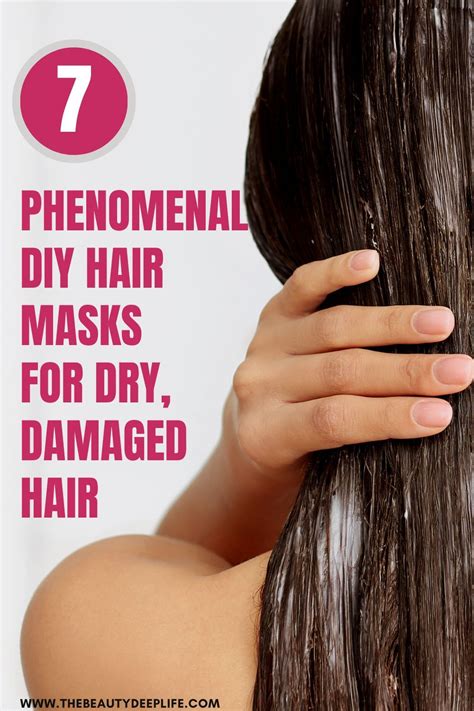Damaged hair is a common problem that can stem from various factors, including chemical treatments, heat styling, environmental stressors, and sun exposure. The outermost layer of hair, known as the cuticle, is made up of scales that lie flat and overlap, protecting the inner layers. When damaged, these scales lift and break, leading to hair that is dry, brittle, and prone to breakage.

Restoring the health of damaged hair requires a comprehensive approach that includes using hair masks specifically designed for repair and nourishment. These masks penetrate the hair shaft, providing essential nutrients, hydration, and conditioning to strengthen the hair and improve its overall appearance.
Effective hair masks for damaged hair typically contain a blend of ingredients that target specific hair concerns:
- Hydrating agents: Hyaluronic acid, ceramides, and glycerin draw moisture into the hair shaft, restoring hydration and preventing dryness.
- Protein-rich ingredients: Keratin, collagen, and silk amino acids rebuild the hair’s structure, strengthening it from within.
- Antioxidants: Green tea extract, vitamin C, and vitamin E protect hair from environmental damage and free radicals.
- Moisture-locking ingredients: Shea butter, coconut oil, and argan oil create a protective barrier around the hair, sealing in moisture and preventing further damage.
- Exfoliating ingredients: Enzymes and alpha hydroxy acids remove dead skin cells and product buildup from the scalp, promoting healthy hair growth.
Regular use of hair masks for damaged hair offers numerous benefits:
- Strengthens hair: Repairing damaged hair cuticle scales makes hair stronger and less prone to breakage.
- Improves elasticity: Nourishing ingredients restore hair’s elasticity, allowing it to withstand stretching without snapping.
- Reduces frizz: Hydrated and moisturized hair is less prone to frizz and flyaways.
- Enhances shine: Healthy, well-nourished hair reflects light better, resulting in a lustrous shine.
- Promotes hair growth: Healthy hair follicles are better able to produce healthy hair strands.
- Wash hair: Start with freshly washed hair to remove any dirt, oil, or styling products.
- Apply mask: Apply the hair mask liberally to damp hair, focusing on the damaged areas.
- Leave in: Follow the manufacturer’s instructions for the required leave-in time.
- Rinse thoroughly: Rinse the mask thoroughly with lukewarm water to remove any residue.
- Condition: Use a conditioner after the mask to further soften and detangle the hair.
- Style as usual: Air-dry or style your hair as desired.
- Olaplex No. 3 Hair Perfector: This professional-grade treatment restores and strengthens bonds within the hair structure.
- Kérastase Résistance Masque Force Architecte: Formulated with keratin and ceramides to reinforce hair fibers and prevent breakage.
- Aveda Damage Remedy Intensive Restructuring Treatment: Contains plant-derived extracts and lipids to repair and moisturize damaged hair.
- Moroccanoil Intense Hydrating Mask: Infused with argan oil and shea butter to deeply nourish and hydrate dry, damaged hair.
- Briogeo Don’t Despair, Repair! Deep Conditioning Mask: Formulated with algae extract and biotin to strengthen, repair, and revitalize damaged hair.
- Consider hair type and damage: Choose a mask that targets the specific type and extent of damage your hair has.
- Read reviews: Research and read reviews before purchasing a hair mask to get insights from other users.
- Look for high-quality ingredients: Opt for masks that contain potent and effective ingredients known for repairing and nourishing damaged hair.
- Follow usage instructions: Adhere to the manufacturer’s instructions for application, leave-in time, and rinsing to ensure optimal results.
- Use regularly: Aim to use a hair mask regularly, such as once or twice a week, to maintain healthy and repaired hair.
Q: How often should I use a hair mask for damaged hair?
A: Generally, once or twice a week is sufficient to provide noticeable benefits.
Q: Can I leave a hair mask in overnight?
A: Most hair masks are not designed to be left in overnight, as this can lead to oversaturation and potential damage.
Q: How long should I leave a hair mask in?
A: Follow the manufacturer’s instructions for the recommended leave-in time, which typically ranges from 5 to 30 minutes.
Q: Can I use a hair mask on dry hair?
A: Yes, some hair masks can be applied to dry hair, but always check the product instructions first.
Q: What are some natural ingredients I can use to make a DIY hair mask for damaged hair?
A: Avocado, honey, coconut oil, and banana are effective natural ingredients for repairing and nourishing damaged hair.
Using a hair mask specifically designed for damaged hair can significantly improve its health and appearance. By incorporating a high-quality hair mask into your hair care routine, you can strengthen, hydrate, and restore your damaged hair to its former glory.
